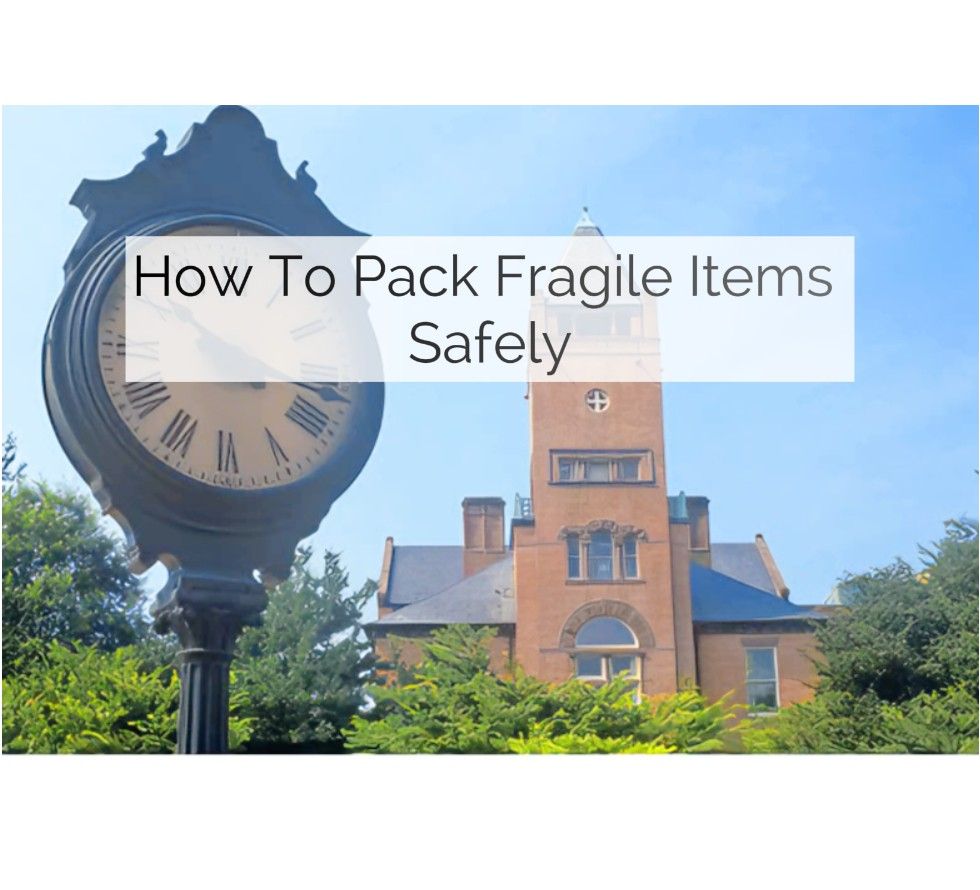
Moving can be an exciting new chapter, but the thought of packing fragile items often brings a wave of anxiety. Will your cherished heirlooms, delicate glassware, or sensitive electronics make it to your new home in one piece? The good news is, with the right techniques and materials, you can significantly reduce the risk of damage. This will walk you through pack fragile items, ensuring your precious belongings arrive at their destination intact.
Packing fragile items requires a meticulous approach, but it's a skill anyone can master. From selecting the right packing materials to employing strategic wrapping and boxing methods, every step plays a crucial role. We're here to share our insider DIY packing tips to help you protect your most vulnerable items.
What Supplies Do You Need to Pack Fragile Items?
To pack fragile items safely, you will need a variety of specialized packing supplies designed for protection and cushioning. Gathering all your materials before you begin will make the packing process much smoother and more efficient.
Here's a list of essential supplies:
- Sturdy Moving Boxes: Opt for double-walled boxes for extra protection, especially for heavier or more valuable fragile items. Small to medium-sized boxes are generally best for fragile items, as they prevent over-packing and excessive weight.
- Packing Paper/Newsprint: Unprinted newsprint is ideal for wrapping items directly, as it won't transfer ink. It's excellent for providing a basic layer of protection and filling small gaps. Treasure Moving Company offers packing services tailored to meet the unique demands of your relocation.
- Bubble Wrap: Essential for cushioning. Choose various sizes – large bubbles for bigger items, small bubbles for more delicate pieces.
- Packing Peanuts: Useful for filling voids in boxes and providing an all-around cushion for irregularly shaped items.
- Foam Sheets/Foam Pouches: Excellent for protecting flat, delicate items like picture frames, mirrors, or plates.
- Heavy-Duty Packing Tape: Secure your boxes with strong, reliable packing tape. "Fragile" tape can also be useful for clear labeling.
- Markers: For clear and prominent labeling of boxes.
- Scissors/Box Cutter: For cutting tape and packing materials.
Labels/Stickers: To clearly mark boxes as "FRAGILE" and indicate their contents and destination room.
How Should You Prepare Fragile Items Before Packing?
Before you begin packing, it is crucial to clean and prepare your fragile items to ensure they are safe and secure. Proper preparation helps prevent damage during transit and makes unpacking easier.
For items like glassware or dishes, ensure they are clean and dry. For electronics, disconnect all wires, bundle them neatly, and place them in a bag labeled with the device it belongs to. For lamps, remove shades and bulbs, packing them separately. Disassemble any items that can be safely taken apart to reduce their size and make them less prone to breakage. For instance, carefully remove glass shelves from display cabinets and wrap them individually. Treasure Moving Company, with years of expertise in handling delicate possessions, understands the nuances of secure residential moving services.
What is the Best Method for Packing Glassware and Dishes?
The best method for packing glassware and dishes involves individual wrapping, strategic layering, and proper cushioning within a sturdy box. This multi-layered approach significantly reduces the risk of breakage.
Here's a step-by-step guide:
- Wrap Each Item Individually:
- Plates: Place a sheet of packing paper flat on a surface. Put a plate in the corner and roll it diagonally, tucking in the sides as you go. Secure with tape. For extra protection, especially for valuable china, wrap plates individually in bubble wrap after the paper.
- Bowls: Wrap bowls similarly to plates, or crumple paper inside the bowl before wrapping the exterior.
- Glasses/Cups: Crumple some packing paper and place it inside the glass. Then, lay the glass on a flat sheet of paper and roll it up. Fold the excess paper over the top and bottom. You can then wrap 2-3 wrapped glasses together in another sheet of paper for added stability.
- Prepare the Box: Line the bottom of your box with a generous layer (at least 2-3 inches) of crumpled packing paper, bubble wrap, or packing peanuts to create a soft cushion.
- Load the Box Strategically:
- Plates and Saucers: Pack plates on their edge, vertically, like records in a crate. This method distributes pressure more evenly than stacking them flat.
- Bowls: Pack bowls either nested (with packing paper between each) or on their sides, depending on their shape and stability.
- Glasses: Place glasses upright or upside down in the box, never on their sides, as the rims and bases are typically the strongest points.
- Fill All Voids: Once items are placed, fill any remaining gaps in the box with crumpled packing paper, packing peanuts, or bubble wrap. The goal is to ensure nothing can shift or move during transit. Shake the box gently; if you feel movement, add more cushioning.
- Seal and Label: Securely tape the box shut with heavy-duty packing tape. Clearly label the box on multiple sides with "FRAGILE," the contents (e.g., "Kitchen - Dishes"), and the destination room (e.g., "Kitchen"). This ensures handlers know to exercise extra care.
How Can You Safely Pack Mirrors and Picture Frames?
Safely packing mirrors and picture frames requires robust protection for the glass and frame to prevent cracks or shattering. Specialized mirror boxes or custom crating are often recommended for larger or more valuable pieces.
For smaller to medium-sized mirrors and frames:
- Tape the Glass: Apply an 'X' with painter's tape across the glass surface. This won't prevent breakage but will help hold shattered pieces together if the glass does break, making it safer to handle.
- Wrap in Packing Paper: Wrap the entire item in several layers of packing paper.
- Add Cardboard Corner Protectors: Use cardboard or foam corner protectors to reinforce the most vulnerable parts of the frame.
- Bubble Wrap Extensively: Wrap the entire item in at least 2-3 layers of large bubble wrap, securing it with tape.
- Use a Mirror Box: Purchase specialized mirror boxes that are designed to fit various sizes of flat items. These boxes are often telescoping, allowing them to adjust to the item's dimensions.
- Cushion the Box: Line the mirror box with crumpled packing paper or foam sheets on the bottom and sides. Place the wrapped mirror inside, then fill any remaining voids with more cushioning to prevent movement.
Label Clearly: Mark the box clearly with "FRAGILE - GLASS" and an arrow indicating which way is "UP."
What is the Best Way to Pack Electronics and Small Appliances?
The best way to pack electronics and small appliances involves careful disconnection, individual wrapping, and secure placement in sturdy boxes with ample cushioning. Retaining original packaging is always a plus.
- Disconnect and Organize Cables: Before unplugging, take a photo of the back of your electronics to remember where all the cables go. Disconnect all wires and cables, then bundle and label them with painter's tape or zip ties. Place them in a sealed bag and tape it to the corresponding device or pack it in the same box.
- Remove Peripherals: Take out any removable parts like printer cartridges, glass trays from microwaves, or turntable platters, and pack them separately if necessary.
- Original Packaging (If Available): If you still have the original boxes and packing materials, use them! They are designed specifically to protect your device during transit.
- Wrap Individually: If original packaging isn't available:
- Smaller Electronics (e.g., Laptops, Tablets): Wrap in anti-static bubble wrap or foam sheets, then place in a padded laptop bag or a snug box.
- Larger Electronics (e.g., TVs, Monitors): For TVs, consider a specialized TV box, often available at moving supply stores. Wrap the screen in a soft blanket or foam sheet before covering the entire unit in bubble wrap. For monitors, protect the screen first, then the whole unit.
- Small Appliances (e.g., Toasters, Blenders): Wrap thoroughly in bubble wrap and secure with tape.
- Cushion the Box: Line the bottom of a sturdy, appropriately sized box with crumpled packing paper or packing peanuts.
- Pack and Fill Voids: Place the wrapped item in the center of the box. Fill all empty spaces around and above the item with packing peanuts or crumpled paper to prevent shifting.
- Label Clearly: Label the box with "FRAGILE - ELECTRONICS," "THIS SIDE UP," and the contents.
How Can You Maximize Safety When Loading Fragile Boxes onto the Moving Truck?
Maximizing safety when loading fragile boxes onto the moving truck involves strategic placement, proper securing, and keeping them separate from heavy, non-fragile items. This prevents shifting and crushing during transport.
- Load Last, Unload First: Fragile boxes should typically be among the last items loaded onto the truck and the first to be unloaded. This minimizes the time they are subjected to vibrations and potential shifting from other items.
- Top Placement: Always place boxes marked "FRAGILE" on top of sturdier, heavier boxes. Never place heavy items on top of fragile ones.
- Secure Them: Once fragile boxes are loaded, ensure they are snugly packed to prevent movement. Use moving blankets, furniture pads, or even more crumpled packing paper to fill any gaps between boxes or between boxes and the truck walls.
- Designated Area: If possible, designate a specific area in the truck for all fragile items, away from high-traffic zones or areas where heavy furniture might shift.
Key Takeaways
- Gather all supplies before you start packing fragile items, including sturdy boxes, various wrapping materials, and strong tape.
- Individually wrap each fragile item using appropriate materials like packing paper, bubble wrap, or foam.
- Cushion generously inside boxes with crumpled paper, peanuts, or bubble wrap to prevent movement.
- Pack strategically, placing heavier fragile items at the bottom of the box and lighter ones on top, and standing plates on their edge.
- Label clearly with "FRAGILE," contents, and destination room to ensure proper handling.
- Load fragile boxes last onto the moving truck and place them on top of other items to prevent crushing.
Successfully moving fragile items doesn't have to be a source of stress. By following these detailed guidelines, you can significantly increase the likelihood of your cherished possessions arriving at your new home in perfect condition. However, patience and proper technique are your best allies.
Should the task of packing delicate items feel overwhelming, or if you have particularly valuable or oversized fragile pieces, don't hesitate to reach out to the professionals. Treasure Moving Company, Your Rockville, MD, Movers specializes in safe and efficient moves, offering expert packing services tailored to your needs. Trust us to handle your treasures with the care they deserve, making your transition as smooth and stress-free as possible.

